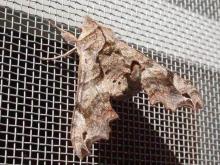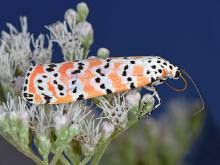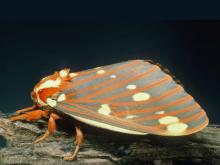Butterflies and Moths
Media

Species Types
Scientific Name
Subfamily Herminiinae
Description
Litter moths are a subfamily of rather nondescript brownish moths, often with intricate patterns that camouflage them as they rest on tree bark or among leaves on the forest floor.
Media

Species Types
Scientific Name
Deidamia inscriptum
Description
The lettered sphinx is the earliest of our sphinx moths to emerge in springtime and may be seen starting in March and April. This single-brooded resident uses wild grapes, Virginia creeper, and peppervine as its caterpillar food plants.
Media

Species Types
Scientific Name
Ceratomia hageni
Description
Hagen's sphinx is also called Osage orange sphinx for its larval food plant. Fresh adults will have a beautiful olive-green cast, while older individuals will look more tan.
Media

Species Types
Scientific Name
Costaconvexa centrostrigaria (formerly Orthonama centrostrigaria)
Description
The bent-line carpet and several similar geometrid moths are called carpet moths for their intricate wing patterns, reminiscent of the traditional carpets of Asia and the Middle East.
Media

Species Types
Scientific Name
Patalene olyzonaria
Description
The juniper-twig geometer is one of many geometrid moths that look like a dried-up leaf. Look for them around porch lights April through November. Larvae eat junipers, including eastern red cedar.
Media

Species Types
Scientific Name
Megalographa biloba (formerly Autographa biloba)
Description
The bilobed looper moth has a conspicuous B-shaped silvery spot on each forewing. Caterpillars of this noctuid moth eat a wide range of plants, and this species is widespread.
Media

Species Types
Scientific Name
Utetheisa ornatrix
Description
The ornate bella moth, also called the calico moth and rattlebox moth, is one of Missouri’s most attractive moths. The colors, however, are a warning to predators that this moth is toxic if eaten. Even spiders reject them.
Media

Species Types
Scientific Name
Citheronia regalis
Description
The enormous, horned caterpillars of regal moths are more famous than the winged adults. This splendid moth is well established in the Ozarks and eastern Missouri.
Media

Species Types
Scientific Name
Eacles imperialis
Description
The beautiful imperial moth is impossible to confuse with any other species in Missouri: the wings are yellow with spots and speckles of pink, orange, or rusty pale purple. Wingspan can be 5½ inches.
Media

Species Types
Scientific Name
Hypercompe scribonia (syn. Ecpantheria scribonia)
Description
The giant leopard moth is a beautiful large white moth. The forewings have numerous black spots, many with hollow centers. Some of the dark markings are iridescent blue in the light.
See Also


Media

Species Types
Scientific Name
About 1,500 species in North America north of Mexico
Description
Adult caddisflies are mothlike. Their larvae are aquatic and build portable, protective cases out of local materials, including grains of sand, bits of leaves and twigs, and other debris.
Media

Species Types
Scientific Name
Corydalus cornutus
Description
Adult eastern dobsonflies are huge and mothlike, with large wings and a weak, fluttery flight. The fiercely predaceous aquatic larvae, called hellgrammites, are well-known to anglers, who often use them as bait.
About Butterflies and Moths in Missouri
Butterflies, skippers, and moths belong to an insect order called the Lepidoptera — the "scale-winged" insects. These living jewels have tiny, overlapping scales that cover their wings like shingles. The scales, whether muted or colorful, seem dusty if they rub off on your fingers. Many butterflies and moths are associated with particular types of food plants, which their caterpillars must eat in order to survive.





















